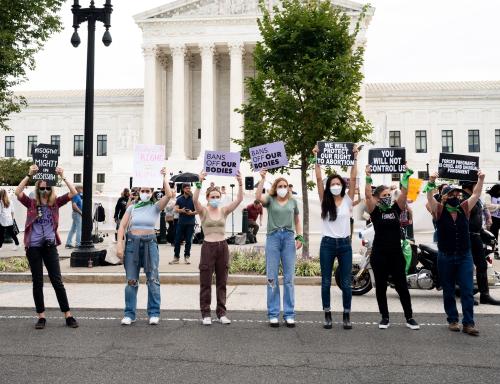This article is an updated version of a piece that appeared in these pages on April 12.
Not since the days of Jim Crow—when some states segregated African Americans in public places and others didn’t—have the rights of Americans been so clearly differentiated by state as they will be if, as expected, the Supreme Court overturns Roe v. Wade, the 1973 decision legalizing abortion. That decision appears all the more likely with a draft of a majority decision that was leaked this week from the Court. States, however, are not waiting for the Court’s decision; thus, the contours of the post-Roe world are beginning to come clear. They are rapidly dividing into two camps—states that will ban all or most abortions and states that are codifying reproductive health protections and preparing for an influx of women seeking abortions.
Let’s start with the better-known story—states seeking to ban abortions. Beginning with the Mississippi law that bans abortions after 15 weeks and continuing with the Texas law that bans abortions after 6 weeks, states have rushed to enact copycat laws that include either a 6 week ban or a 15 week ban along with penalties for abortion providers and for those who provide information on abortion. As of this writing, there are 13 states that have passed what is called a “trigger law.” These laws would ban abortion altogether if Roe is reversed. Finally, there are other states such as Michigan that have laws on the books banning abortion that pre-dated the Roe v. Wade decision. These laws would, presumably, go into effect once Roe was overturned.
The following map from the Pew Charitable Trusts shows which states are likely to end up banning most or all abortions.

While states enacting abortion bans have gotten the most media attention, states where the legislatures are sympathetic to abortion rights are also enacting laws to expand and protect such rights and to counter the movement in states limiting abortions. Sixteen states plus the District of Columbia protect the right to abortion through state law. Other states, like New Mexico, are likely to pass similar laws soon. California passed a major law protecting the privacy of women wanting abortions and addressing racial and economic inequities in access by providing abortion coverage under Medicaid. Washington state passed a law prohibiting legal action against those who seek abortion and those who help them.
It is clear that some states are preparing to be abortion providers to more women than just those in their state. Recently, the Maryland legislature passed a law which would appropriate money to train medical professionals, such as nurse practitioners; nurse midwives; and physician assistants, to perform abortions. Expect other states to follow in Maryland’s footsteps and increase their capacity to conduct abortions. (The state’s Republican Gov. Larry Hogan, vetoed the bill but it was overturned by the legislature.) In Oregon, the legislature appropriated $15 million to help the state expand its abortion workforce. Most recently, Connecticut passed a law that would also expand the number of medical professionals who can provide abortions and would shield resident abortion providers from facing penalties under abortion laws in other states.
What is likely to emerge from this picture is an America where women with unwanted pregnancies will still be able to get abortions. But to do so, they will need:
- access to information about abortion providers in other states,
- the ability and discipline to keep their plans to themselves,
- the time and financial resources to travel out of state.
Let’s look at each of these in turn. First, access to information is easier for those with financial means and those who are better educated. An upper middle-class mother with a 16-year-old with an unwanted pregnancy will be able to find a clinic and buy two plane tickets to Baltimore, much as well off women before Roe v. Wade traveled to Sweden. But abortion is most prevalent among women in their twenties who are low income. For poor and uneducated women, local public health entities (whether public or private) have provided information on everything from birth control to abortion, and they will be out of business.
In those states intent on banning abortion, legislators are also passing or proposing laws which ban or criminalize those who seek to help women obtain abortions. The Texas law, which is being copied in many states, allows private citizens to sue anyone who helps someone get an abortion. The plaintiffs could be awarded up to $10,000. In Missouri, state representative Mary Elizabeth Coleman has proposed legislation making it illegal to help someone get an abortion even in a different state. According to St. Louis Public Radio, “Coleman’s proposed amendments would criminalize facilitating the procedure: transporting someone to have an abortion, helping pay for the procedure or instructing them on ways to end a pregnancy.”
Non-profit organizations like Planned Parenthood that serve, in part, low-income women will be in substantial legal jeopardy if they give out information about how to get an abortion out of state. For educated women able to find their own information it means they need to keep quiet about what they are doing and where they are going, less it prompts a neighbor or a co-worker to tell on them.
Next, as the map indicates, getting from a state that prohibits abortion to one that doesn’t will mean, for many, a substantial trip—either on an airplane or a train. Even if the woman decided to drive, travelling to an abortion-legal state entails time off from work and lost income, hotel or motel costs, and food costs. Not to mention, the experience will involve the trauma of having to recover from a medical procedure far from home.
In abortion-legal states, there will no doubt be many private organizations springing up to help defray the costs of travel. But once again, access to this information will be difficult to come by for younger and less educated women. In post-Roe America, the most difficult part for women seeking abortions is not likely to be money or even geography—it is likely to be information. This is why anti-abortion states are considering a range of options to block information that will not impact all women equally. It will disproportionately hurt less educated women, women of limited economic means, and women of color.
The next battle will be over the information and the means provided to get women from the abortion banning states to the abortion providing states. Will we face a dystopian future where the routes to abortion states become well organized and financed and where Congress tries to pass laws returning pregnant women to their states before they can have an abortion? Recently, a woman in Texas was arrested, charged with murder, and jailed after a self-induced abortion. Although no one pressed charges, the event sent chills down the spines of women all over America.
What’s next? Will state police force women of child-bearing age to have a pregnancy test before boarding a plane to Maryland, New York, or any other state where abortion is legal? Will local authorities hack into the computers of women and arrest those searching for information about abortions in other states or about medication abortions?
In a nation where a substantial number of people revolted against mask wearing and Covid vaccines as an intrusion on their medical privacy and choice, efforts to stop abortion altogether are likely to run into a tsunami of fury.
Passing abortion bans is the easy part; preventing abortions will turn out to be much more difficult.






Commentary
What happens after Roe v. Wade?
May 3, 2022